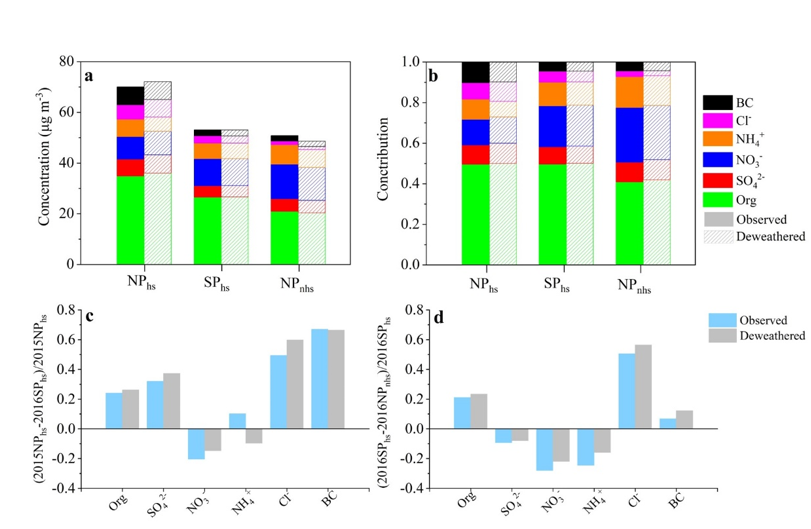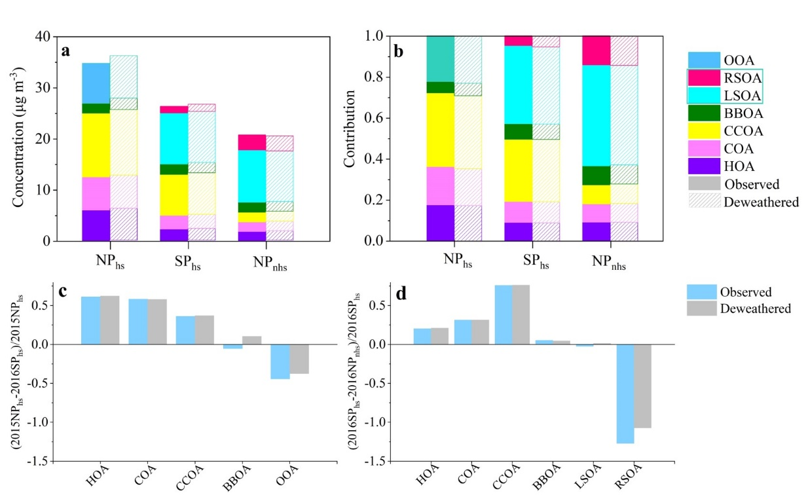Wang, Y., Huang, R.J.*, Xu, W., Zhong, H.B., Duan, J., Lin, C.S., Gu, Y.F., Wang, T., Li, Y.J., Ovadnevaite, J., Ceburnis, D., O'Dowd, C.: Staggered-peak production is a mixed blessing in the control of particulate matter pollution. npj Clim. Atmos. Sci., 5, 99, 2022.
Particulate matter (PM) pollution exerts profound impacts on human health, climate, visibility, and ecosystem. Recent years, various stringent pollution prevention and control measures have been implemented nationwide to alleviate air pollution. Staggered-peak production (SP) - a measure to halt industrial production in heating season - has been implemented in North China Plain to reduce the cement production overcapacity and to improve air quality. However, the effectiveness of this policy in mitigating PM pollution is yet to be evaluated.
A research group led by Prof. Huang Rujin from the Institute of Earth Environment of the Chinese Academy of Sciences (IEECAS) conducted an online real-time field observation in China’s National Center for Nanoscience and Technology (NCNST). The aerosol chemical composition of PM1 and OA factors in Beijing in 2015 and 2016, which covers the periods in the normal production (NP) period during 2015 heating season (NPhs), in the SP period during 2016 heating season (SPhs) and in the normal production (NP) period during 2016 non-heating season (NPnhs), are investigated. The PM1 mass concentration decreased from 70.0±54.4 μg m-3 in NPhs to 53.0±56.4 μg m-3 in SPhs, with prominent reductions of primary emissions. However, the fraction of nitrate during SPhs (20.2%) was roughly twice that during NPhs (12.7%) despite of a large decrease of NOx, suggesting an efficient transformation of NOx to nitrate during SP period. This is consistent with the increase of oxygenated organic aerosol (OOA) which almost doubled from NPhs (22.5%) to SPhs (43.0%) in the total organic aerosol (OA) fraction, highlighting efficient secondary formation during SP. The PM1 loading was similar between SPhs (53.0±56.4 μg m-3) and NPnhs (50.7±49.4 μg m-3), indicating a smaller difference in PM pollution between heating and non-heating seasons after the implementation of the SP measure. In addition, a machine learning technique was used to decouple the impact of meteorology on air pollutants. The deweathered results were comparable with the observed results, indicating that meteorological conditions did not have large impacts on the comparison results.
This study, published in npj Climate and Atmospheric Science, highlights that the SP policy is effective in reducing primary emissions but promotes the formation of secondary species.

Fig. 1 Comparisons of PM1 species between deweathered and observed results. a Mass concentrations and b fractions of deweathered and observed PM1 species during the NPhs, SPhs and NPnhs. The observed and deweathered change ratios of PM1 species between c NPhs and SPhs , d SPhs and NPnhs (The bars below horizontal line represent increase ratios and the bars above the horizontal line represent decrease ratios of PM species).

Fig. 2 Comparisons of OA factors between deweathered and observed results. a Mass concentrations and b fractions of deweathered and observed OA factors during the NPhs, SPhs and NPnhs. The observed and deweathered change ratios of OA factors between c NPhs and SPhs , d SPhs and NPnhs (The bars below horizontal line represent increase ratios and the bars above the horizontal line represent decrease ratios of OA factors).

